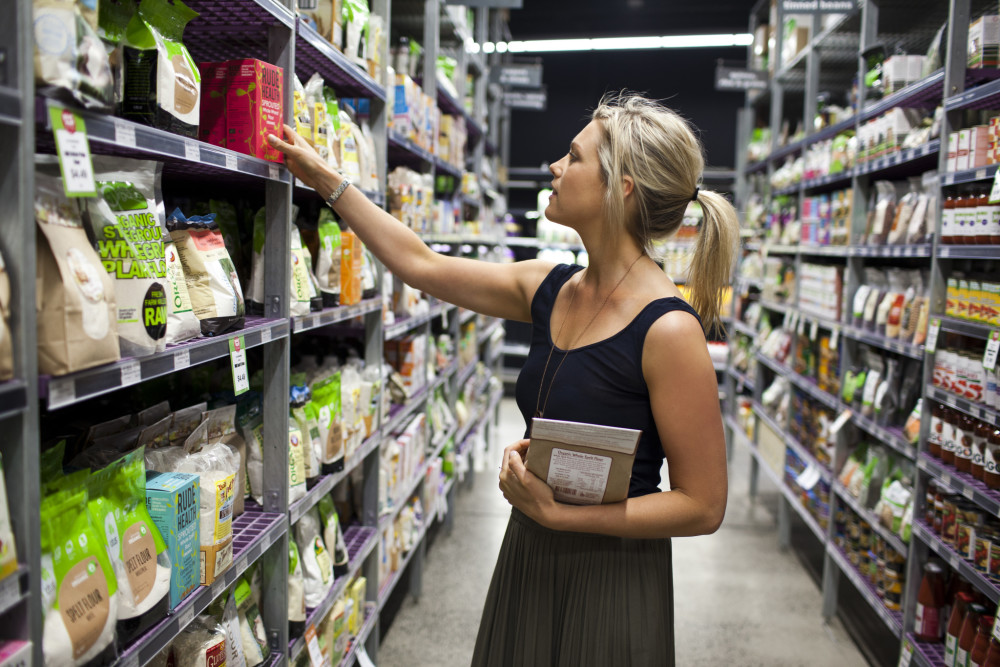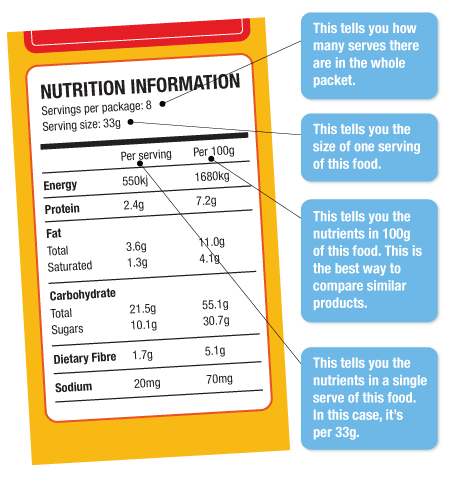 Learning to read food labels can be one of the best ways to make sure you’re choosing the healthiest foods possible. But they can seem like a mess of confusing words, dubious claims and intimidating tables, and let’s be honest, we generally want to get out of the supermarket as quickly as possible, not spend hours standing in the aisles reading labels!
Learning to read food labels can be one of the best ways to make sure you’re choosing the healthiest foods possible. But they can seem like a mess of confusing words, dubious claims and intimidating tables, and let’s be honest, we generally want to get out of the supermarket as quickly as possible, not spend hours standing in the aisles reading labels!
So I’m going to break it down into 5 steps you can follow so that you can quickly decode all the information and ultimately work out if this is a food you want to be eating or not. Here they are:
Step 1. Find the Ingredients List (what foods is the product made from?)
The most important thing to consider is what’s actually in the food – knowing the calorie content or type of fat is all well and good, but we eat food, not nutrients so a quick scan of the ingredients list is the best way to determine the nutritional value of a product.
Ingredients are listed (generally underneath the nutrition information panel) in order of largest to smallest, by weight. So, if the first ingredient listed is sugar, that means that sugar is the main ingredient in that product.
When you’re looking at the ingredients list, see how many items are in it, and whether you recognise these foods or not. If the product has a ridiculously long list of unpronounceable ingredients, it might be best left on the shelf.
Step 2. Find the Nutrition Information Panel (what nutrients is the product made from?)
There are two columns in the NIP – ‘per 100g’ and ‘per serve’. The per serve column is useful to look at as you want to work out how much of these nutrients you will actually be eating. The per 100g column allows you to compare this product with other products and see which one comes out best (as different products will most likely have different serving sizes).

Image thanks to raising children.net.au
What’s listed in the Nutrition information panel:
Energy – may be listed as kilojoules or kilojoules and calories (1 calorie=4.2 kilojoules)
Protein
Carbohydrates
Total: includes all types of carbohydrate; sugar, starch and fibre.
Sugars: just the sugar component of the carbohydrate
Fat
Total: Includes both saturated and unsaturated fats
Saturated: The type of fats that contribute to cardiovascular disease (i.e. the ones we want to avoid)
NB: both types of fats have the same energy (calorie) content
Sodium:tells us how much salt is in the product
Depending on the type of food, fibre, vitamins and minerals such as calcium may also be included
Step 3. Focus on sugar, saturated fat and sodium
Calories (kilojoules) are only part of the story. Yes, if you’re trying to lose weight, consuming less calories than you burn off is what matters at the end of the day. But the calorie content of a food tells us nothing about it’s nutritional value. Overall, we want to be aiming for minimal amounts of added sugar, saturated fat and sodium in our diets, so these are the things to focus on in the nutrition information panel.
There’s sugar and then there’s sugar
Sugar that is added into a product is the type to avoid, not sugars naturally present in foods such as dairy products and fruit. But here’s where it gets a bit tricky. In some foods such as flavoured yoghurt and fruit based products, the natural sugars present in the food are not separated from the added sugars, so it is very difficult to know how much sugar has been added in. In a flavoured yoghurt for example, the sugar content in the NIP may look relatively high, but around half of this sugar is lactose, the natural sugar present in milk – so bear this in mind when checking the sugar content.
Fat – the good and the bad
Fats are separated into total and saturated. The fat which isn’t saturated fat is unsaturated fat, the healthy ones found in foods like olive oil, oily fish, nuts, seeds and avocado. Saturated fats are the type which we want to limit as they contribute to cardiovascular disease. They’re found in animal products, coconut products and many highly processed snack foods.
Fibre
Fibre is an important nutrient that we need to be having plenty of in our diets. Fibre may or may not be listed on the NIP, unlike the other nutrients its not legally required unless the food makes a claim about its fibre content (e.g. ‘high in fibre’). If fibre is listed, go for the product with the highest fibre.
Step 4. Look at the ‘per serve’ column
When it comes to nutrition and healthy eating, size definitely matters. This column will tell you exactly how much of each nutrient you are going to eat. But, beware – the ‘serve’ used in the ‘per serve’ column is determined by the manufacturer, so it’s not necessarily realistic and may be completely different to what you would classify as ‘a serve’.
Often a very small serve size will be given so that the product appears to have fewer calories and less fat,sugar etc. For example, breakfast cereals will often state the serve size of 30g, but I don’t know many people who only eat 30g of cereal! So make sure you consider what your actual serving size would be compared to the serving size stated on the package.
Step 5. Look at the ‘per 100g’ column
The per 100g column allows you to compare different brands of a similar product – have a quick glance at a few different types of the same product and choose the one which has the lowest saturated fat/sugar/sodium or highest fibre. It might be a bit of a pain to do, but you only need to do it once.
OK, so give me some numbers?
There are some products which by their very nature will be high in one of these nutrients, e.g. jam will always be high in sugar, chicken stock will always be high in sodium, olive oil will always be high in fat, all foods are very different, so its difficult to set targets that can be used across the board. But as a general guide aim, the healthiest products will have:
Sugar: less than 10g sugar per 100g (or if a product contains fruit less than 20g/100g)
Fat: less than 5g total fat per 100g (and the lowest amount of saturated fat possible)
Sodium: less than 300mg per 100g
The bottom line is that overall, limiting the amount of highly processed, packaged foods you eat and opting for fresh, minimally processed foods wherever possible is the best way to ensure your diet is as healthy as possible. However, packaged foods certainly have a place in a healthy diet are often important from a convenience point of view. Plus, some of them are just plain delicious (I don’t care what the nutrition information panel says, there’s no way I’m giving up chocolate!). But having a quick glance at the information on the label and being able to work out what it means allows you to be more informed about what you’re eating and to choose healthier options.
And remember, when it comes to food labels it pays to be skeptical!
This could be a whole other post on its own, but for the sake of keeping this as concise as possible, the bottom line is: food manufacturers want you to buy their products and it’s their job to try and convince you to do so. There are strict laws about food labelling that manufacturers must follow so that consumers are not deliberately misled, but it can still be easy to fall into marketing traps. Here are a couple in particular to look out for.
Health claims: Sometimes labels will include claims such as ‘low in fat’, ‘high in fibre’, ‘good source of calcium’ etc. These claims can only be used if the food meets certain strict criteria, so they can be a useful tool in identifying healthier products. However, in some cases, these claims be misleading to the untrained eye. ‘Reduced fat’ for example is not the same as ‘low fat’, it simply means that it is lower in fat than a comparable product. So ultimately it could still be relatively high in fat.
Using other words for fat, sugar and salt: this is another favourite trick, here are some of the alternative names for fat, sugar and salt you might find in an ingredients list
| FAT | SUGAR | SALT |
| Butter | Glucose | Sodium |
| Vegetable Oil | Sucrose | Monosodium Glutamate (MSG) |
| Lard | Maltose | Yeast Extract |
| Palm oil | Lactose | Baking Soda |
| Milk Solids | Dextrose | Vegetable salt |
| Monoglycerides | Fructose | Sea salt |
| Diglycerides | Mannitol | Sodium Bicarbonate |
| Coconut oil | Sorbitol | |
| Shortening | Xylitol | |
| Margarine | Corn Syrup | |
| Disacharides | ||
| Honey | ||
| Evaporated cane juice (my personal favourite) |
Thank you for taking the time to explain how to effectively read nutrition labels. First off, I think that it is absolutely amazing that we can determine the nutritional facts of any food. However, being able to read those facts is another thing completely. I like that you said the bottom line when eating healthy is that you eat more natural foods and less processed foods. Thanks for the post!